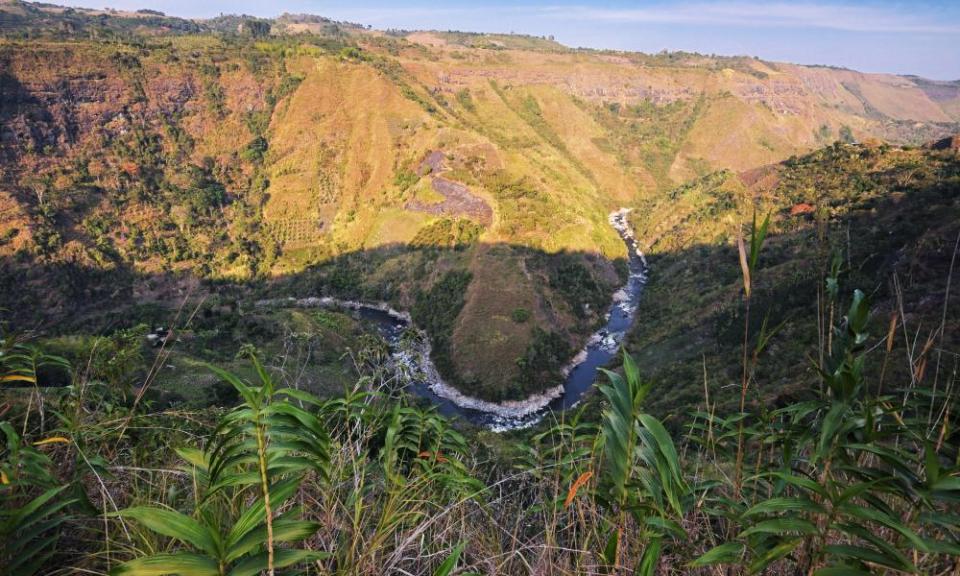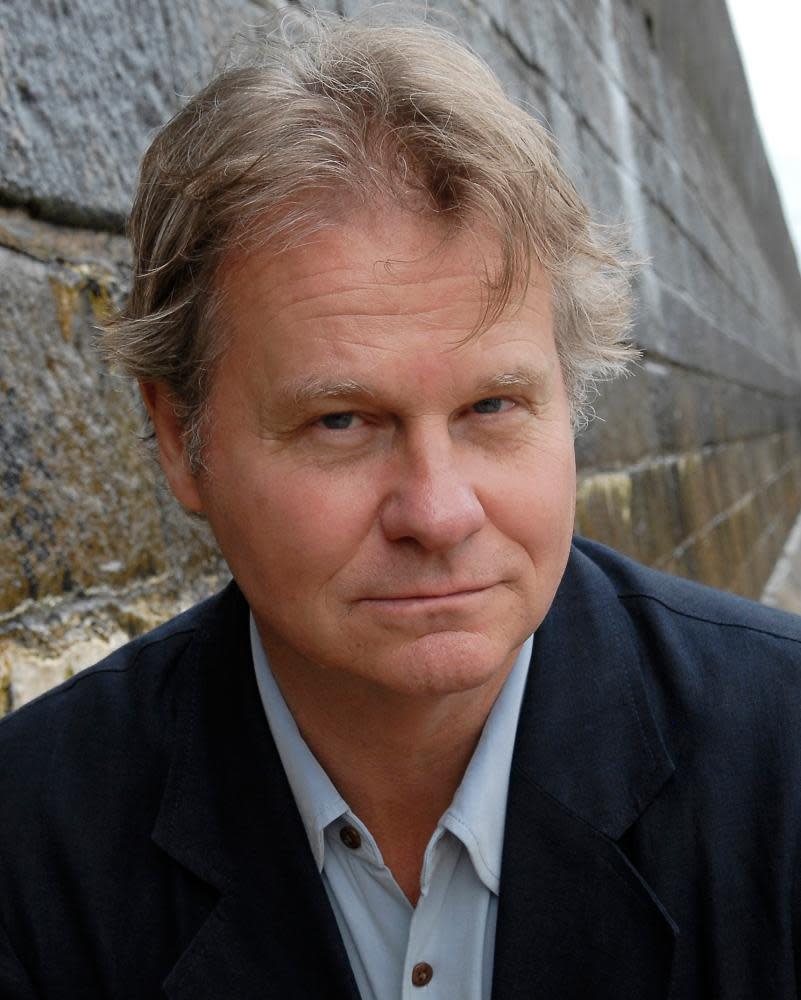Magdalena by Wade Davis review – a journey down Colombia's river of dreams
The Magdalena is the great arterial river of Colombia. Rising in the rugged moorlands of the Andean páramo 12,000ft above sea level, it flows northwards for nearly a thousand miles, carving its way through gorges fringed with cloud forest, skirting the mysterious megaliths of San Agustín, growing fat and turbid in its lower reaches, and finally debouching into the Caribbean at the Bocas de Ceniza (the “ashen mouths”), where its tonnage of silt turns the sea grey.
Few know its moods and secrets better than the Canadian author, photographer and anthropologist Wade Davis, whose many distinctions include the impressive post of “explorer in residence” at the National Geographic Society. He first visited Colombia in 1968, on a school trip. He was 14 years old. “Several of the older Canadian students longed for home,” he recalls. “I felt as if I had finally found it.” In 2018 he was granted honorary Colombian citizenship.
Davis is a powerful, penetrating and immensely knowledgeable writer. He first grabbed attention with his high-octane account of voodoo rituals in Haiti, The Serpent and the Rainbow (1985), an atmospheric work of reportage which drew comparisons with Hunter S Thompson and Carlos Castaneda, while also being a meticulous scientific enquiry into the pharmacology of potions associated with the creation of “zombies”. Davis was then a graduate student at Harvard, studying under the ethnobotanist Richard Evans Schultes, to whom he later paid homage in One River (1996) – not quite a biography, more an extended psychotropic field-trip, retracing his mentor’s amazing forays into uncharted corners of South America in search of hallucinogenic plants and the shamanistic traditions associated with them.
Madgalena is a geography book about a river that is also a political history of Colombia, an admonition of ecological disaster, an impassioned defence of indigenous wisdom, and a memoir of the author’s various travels and friendships over the years. Like that other fine book about the Magdalena, Michael Jacobs’s The Robber of Memories (2012), it is very personal. Its three sections – “Alto”, “Medio” and “Bajo” Magdalena – promise a smooth linear ride downriver, but the text is full of mysterious eddies and crosscurrents. In his summary, Magdalena is “less a work of scholarship than a compendium of stories shared by Colombians encountered along the river and beyond”. These “living narratives” are the heart of a book whose final purpose is to “celebrate the true wonder of a country that has long been overlooked and misunderstood”.

Passages of description catch the evanescent flavour of towns along the way. Here are the indolent tropical charms of the old colonial port of Santa Cruz de Mompox: “Mompox has a way of slowing down the world, reducing the day to its most casual core, gestures and interludes choreographed only by the heat of the sun ... Along the waterfront splintered shutters creak open to reveal courtyards and private fountains, hidden gardens of fruit trees and orchids ... Elderly couples sip their coffee, already at ease in the wicker rockers where they will spend most of the morning and, quite possibly, much of the day.”
But the idyll is always counterpointed by the harsh truths of Colombian history – the Magdalena as one of the portals for the genocide of the Conquista; the graveyard of countless thousands slaughtered in the civil wars of the 1950s, in the cocaine wars of the 80s, and in the guerrilla insurgencies of the Farc.
Davis compares the Magdalena to the Mississippi. Like that other great river – “its shadow to the north” – it is “both a corridor of commerce and a fountain of culture, the wellspring of Colombian music, literature, poetry and prayer”. Also like the Mississippi, the icon of its glory days was the paddle-steamer – “magnificent three-storey vapores with soaring black chimneys, passing in the night like brightly lit carnival tents”. But these picturesque vessels were also destroyers of the forests fringing the river. In their heyday there were 70 large steamships plying the Magdalena, which is navigable for 500 miles between Barranquilla on the Caribbean coast and the rapids of Honda. The furnaces which powered them were fed with wood, taken aboard at riverside depots. The basic unit was the burro de leña, a donkey-load: roughly 70 3ft-logs. The largest of the steamships consumed 100 burros a day. By the early years of the 20th century, Davis reckons, the vapores had burned some 40m cubic yards of invaluable hardwoods.
There was also a carnage of wildlife. “Vessels became platforms for the hunting of manatees , blue turtles, ocelots and jaguars ... Children cut open the bellies of iguanas, replaced their eggs with manure, and tossed them back into the river.” As late as 1949 a Colombian scientist reported seeing his fellow passengers entertaining themselves by killing caymans with machine guns.
Manatees – hypothesised by early travellers as mermaids – are the classic fauna of the Magdalena, though now seriously endangered. In his memoir, Living to Tell the Tale, Gabriel García Márquez gives a beautiful account of seeing a manatee from the deck of a vapor on a moonlit night: “We were awakened by a heartrending lament from the riverbank. The captain ... gave an order to use searchlights to find the origin of the weeping: it was a manatee female who had become entangled in the branches of a fallen tree ... She was a fantastic, touching creature, half woman and half cow, almost four metres long. Her skin was livid and tender, and her large-breasted torso was that of a biblical matriarch.”

Márquez was one of the great literary celebrants of the Magdalena. Davis notes that in his late novels, Love in the Time of Cholera and The General in His Labyrinth, the river is “not just the setting but an actual character”. Born in the small northern town of Aracataca – the model for his fictional village of Macondo – Márquez made his first river trip in 1943, when he was 16, headed for further education in Bogotá. He was homesick in that chilly, cloudy city; the Magdalena was his “antidote”, the lifeline back to the north, where all was “awash with colour and passion” and “daily life was but a pretence for poetry”.
Two splendid chapters in Davis’s book cover the music of the Bajo Magdalena: cumbia – “the heartbeat of Colombia”; vallenato, with its swirling accordions; tambora, the music of the palenques, villages founded by runaway slaves. In Barranquilla Davis visits Carlos Vives, whose fusions of traditional Colombian music with rock and jazz have attracted an international audience. “If cumbia is the mother of our rhythm,”Vives says, “the mother of cumbia is the Magdalena. The river is our storyteller. It’s what defines us as people.” In Barranco de Loba Davis is taken to meet a local legend, Maestro Ángel María Villafañe, 85 years old, “thin and fit ... with a straw hat tilted at a rakish angle”. To watch this charismatic master of tambora on stage, he is told, is like “having Jagger right in front of you”. The traditional lyrics of the tambora are “raw and elemental”, Davis writes. They are “the poetic words of the unschooled, composed mostly by illiterate men and women singing about the simple moments of life: a bird in flight, a girl in love, the beauty of the river”. People are passionate partisans of one music or another. Cumbia is more widely known, but a fan of tambora tells him: “To dance cumbia is to dance tambora, only slower and with candles.”
“In Colombia,” Davis writes, “there is no limit to what can be squeezed out of a day.” His love of the country is “something visceral ... To be away too long is to be on life support.” Magdalena is steeped in a physical sense of Colombia: the landscapes, the disreputable backstreets, the irrepressibly resilient people. This eclectic log-book of life on the river puts one in mind of Ryszard Kapuściński’s idea of travel writing as “authenticated by its being lived” – “you have experienced this event on your own skin, and it is this experience, this feeling along the surface of your skin, which gives your story its coherence.”
• Magdalena: River of Dreams is published by Bodley Head (£25). To order a copy go to guardianbookshop.com. Delivery charges may apply/


